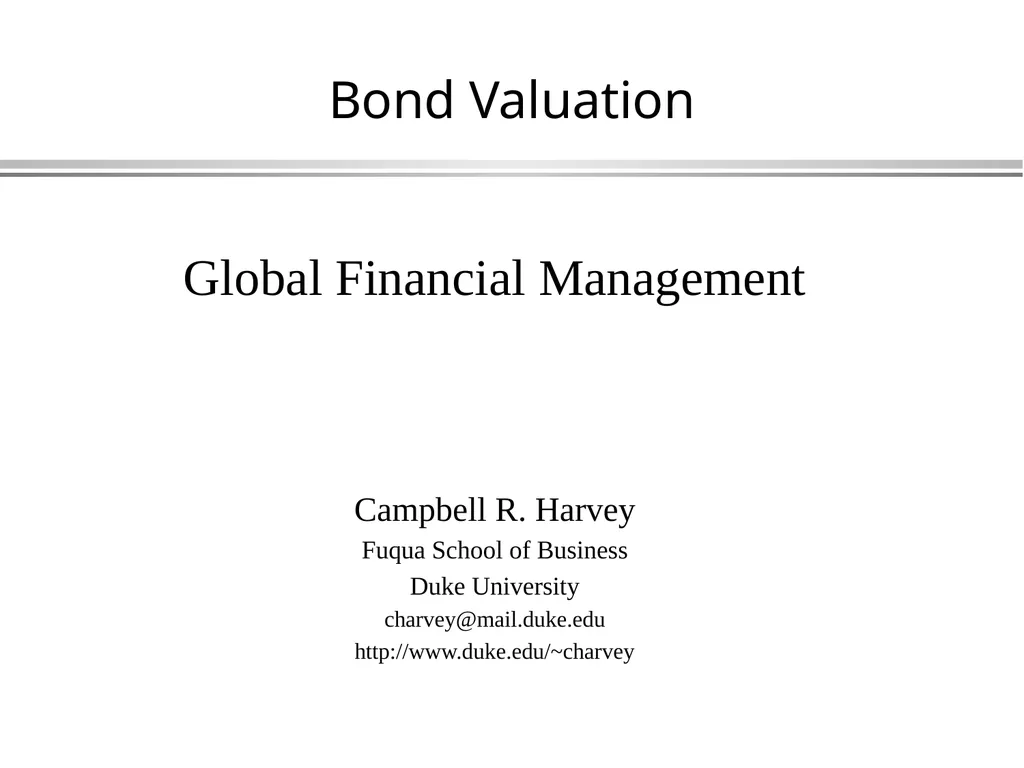Bond Valuation Global Financial Management
Author : briana-ranney | Published Date : 2025-05-16
Description: Bond Valuation Global Financial Management Campbell R Harvey Fuqua School of Business Duke University charveymaildukeedu httpwwwdukeeducharvey Definition of a Bond A bond is a security that obligates the issuer to make specified
Presentation Embed Code
Download Presentation
Download
Presentation The PPT/PDF document
"Bond Valuation Global Financial Management" is the property of its rightful owner.
Permission is granted to download and print the materials on this website for personal, non-commercial use only,
and to display it on your personal computer provided you do not modify the materials and that you retain all
copyright notices contained in the materials. By downloading content from our website, you accept the terms of
this agreement.
Transcript:Bond Valuation Global Financial Management:
Bond Valuation Global Financial Management Campbell R. Harvey Fuqua School of Business Duke University charvey@mail.duke.edu http://www.duke.edu/~charvey Definition of a Bond A bond is a security that obligates the issuer to make specified interest and principal payments to the holder on specified dates. Coupon rate Face value (or par) Maturity (or term) Bonds are sometimes called fixed income securities. Types of Bonds Pure Discount or Zero-Coupon Bonds Pay no coupons prior to maturity. Pay the bond’s face value at maturity. Coupon Bonds Pay a stated coupon at periodic intervals prior to maturity. Pay the bond’s face value at maturity. Perpetual Bonds (Consols) No maturity date. Pay a stated coupon at periodic intervals. Types of Bonds Self-Amortizing Bonds Pay a regular fixed amount each payment period over the life of the bond. Principal repaid over time rather than at maturity. Bond Issuers Federal Government and its Agencies Local Municipalities Corporations U.S. Government Bonds Treasury Bills No coupons (zero coupon security) Face value paid at maturity Maturities up to one year Treasury Notes Coupons paid semiannually Face value paid at maturity Maturities from 2-10 years U.S. Government Bonds Treasury Bonds Coupons paid semiannually Face value paid at maturity Maturities over 10 years The 30-year bond is called the long bond. Treasury Strips Zero-coupon bond Created by “stripping” the coupons and principal from Treasury bonds and notes. Agencies Bonds Mortgage-Backed Bonds Bonds issued by U.S. Government agencies that are backed by a pool of home mortgages. Self-amortizing bonds. Maturities up to 20 years. U.S. Government Bonds No default risk. Considered to be riskfree. Exempt from state and local taxes. Sold regularly through a network of primary dealers. Traded regularly in the over-the-counter market. Municipal Bonds Maturities from one month to 40 years. Exempt from federal, state, and local taxes. Generally two types: Revenue bonds General Obligation bonds Riskier than U.S. Government bonds. Corporate Bonds Secured Bonds (Asset-Backed) Secured by real property Ownership of the property reverts to the bondholders upon default. Debentures General creditors Have priority over stockholders, but are subordinate to secured debt. Common Features of Corporate Bonds Senior versus subordinated bonds Convertible bonds Callable bonds Putable bonds Sinking funds Bond Ratings Valuing Zero Coupon Bonds What is the current market price of a U.S. Treasury strip that matures in exactly 5 years and has a face value of $1,000. The yield to maturity is rd=7.5%. What is the yield to maturity on














